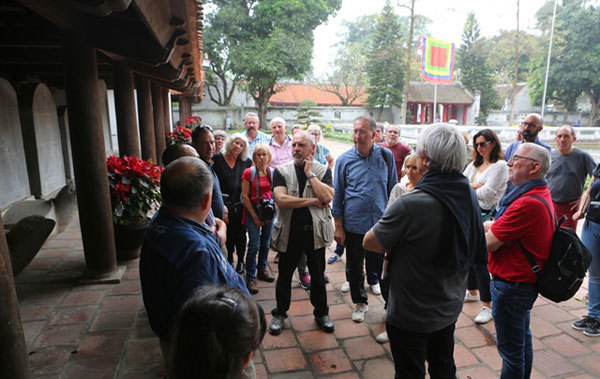 |
| Visitors at the Temple of Literature in Hanoi. The biggest challenge the Hanoi tourism sector has faced is the poor quality services in some tourist sites or hotel services. VNA/VNS Photo |
Can you tell us what are the seven mission groups to promote the development of Hanoi’s tourism sector?
Resolution No 6 of the Party Central Committee has listed seven mission groups for the Hanoi’s tourism sector from 2016-2020. They are as follows.
1. To develop strategies to further expand tourists activities.
2. To develop an overall plan on the city’s tourism development.
3. To develop more high-quality tourism products while developing the Hanoi tourism trademark.
4. To invest more money to upgrade the city’s infrastructure.
5. To have high-quality human resources.
6. To have an appropriate investment budget in the tourism sector.
7. To have good policies serving as a firm foundation for the tourism sector to fly high.
What are the major achievements of the Hanoi tourism sector in the last four years?
From 2016-2019, on average, the number of tourists that came to Hanoi saw an increase of 10.2 per cent per year. For foreign tourists, the annual increase was about 21.2 per cent.
In 2019, Hanoi welcomed 28.9 million visitors, of which more than 7 million were foreigners. In 2019, the Hanoi tourism sector contributed 12.54 per cent to the city’s gross regional domestic product.
More importantly, Hanoi has been selected as one of the world’s top tourist sites with its beautiful attractions and good service.
Can you talk a bit more about the new tourist products Hanoi has offered?
The guiding principles for the Hanoi tourism products are unique, attractive and professional, yet they must be sustainable and accountable to the environment and society.
Many of Hanoi’s tourism products have been highly rated by the tourists like the Van Phuc silk or the Bat Trang ceramics and others.
There are quite a lot of tourist attraction sites for visitors to visit, such as Thang Long Citadel, Van Mieu-Quoc Tu Giam- the first university in Vietnam or the Hoa Lo prison relics where many Vietnamese patriots were detained, including Tran Phu, the first Party General Secretary.
What are the challenges the Hanoi tourism sector has faced in its course of development?
The biggest challenge the Hanoi tourism sector has faced is the poor quality services in some tourist sites or hotel services. Last but not least, the quality of some tourist guides are not yet up to the visitors’ expectation, particularly foreign tourists due to their poor foreign language skills.
What have been the negative impacts of the COVID-19 pandemic on the Vietnamese tourism sector?
The year 2020 has really been a crisis for the Vietnamese tourism sector, including that of Hanoi. For example, in the first four months of 2020, some 1,190 tourist hotels, 1,364 tourist companies and 120 transport companies had to close. As a result, almost 41,000 people lost their jobs. The Hanoi tourism sector has set a target to welcome some 14 million tourists to the city in 2020 (about half of the number that came to the city in 2019), yet Hanoi tourism authorities are not sure if this target will be achieved or not.
Can you talk a little bit about the Hanoi tourism sector’s plans for the next five years?
We have set a target that in 2021, the number of domestic tourists that come to Hanoi will be the same as that of the year 2019 while the foreign visitors will be about 70 per cent compared to 2019. We hope in the year 2022, the number of domestic visitors will increase by 8 per cent compared to that of the year 2021. And from 2023-2025, the number of tourists coming to Hanoi will be increased annually from 8-9 per cent. VNS/Hanoimoi



